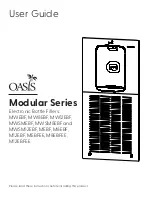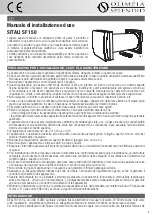
1.2.1. Caution for fuse replacement
1.3. Protection Circuitry
The protection circuitry may have operated if either of the following conditions are noticed:
·
No sound is heard when the power is turned on.
·
Sound stops during a performance.
The function of this circuitry is to prevent circuitry damage if, for example, the positive and negative speaker connection wires are
“shorted”, or if speaker systems with an impedance less than the indicated rated impedance of the amplifier are used.
If this occurs, follow the procedure outlines below:
1. Turn off the power.
2. Determine the cause of the problem and correct it.
3. Turn on the power once again after one minute.
Note:
When the protection circuitry functions, the unit will not operate unless the power is first turned off and then on again.
2 Prevention of Electro Static Discharge (ESD) to
Electrostatically Sensitive (ES) Devices
Some semiconductor (solid state) devices can be damaged easily by static electricity. Such components commonly are called
Electrostatically Sensitive (ES) Devices. Examples of typical ES devices are integrated circuits and some field-effect transistors and
semiconductor "chip" components. The following techniques should be used to help reduce the incidence of component damage
caused by electro static discharge (ESD).
1. Immediately before handling any semiconductor component or semiconductor-equipped assembly, drain off any ESD on your
body by touching a known earth ground. Alternatively, obtain and wear a commercially available discharging ESD wrist strap,
which should be removed for potential shock reasons prior to applying power to the unit under test.
2. After removing an electrical assembly equipped with ES devices, place the assembly on a conductive surface such as
aluminum foil, to prevent electrostatic charge buildup or exposure of the assembly.
3. Use only a grounded-tip soldering iron to solder or unsolder ES devices.
4. Use only an anti-static solder removal device. Some solder removal devices not classified as "anti-static (ESD protected)" can
generate electrical charge sufficient to damage ES devices.
5. Do not use freon-propelled chemicals. These can generate electrical charges sufficient to damage ES devices.
6. Do not remove a replacement ES device from its protective package until immediately before you are ready to install it. (Most
replacement ES devices are packaged with leads electrically shorted together by conductive foam, aluminum foil or comparable
conductive material).
7. Immediately before removing the protective material from the leads of a replacement ES device, touch the protective material
to the chassis or circuit assembly into which the device will be installed.
Caution
Be sure no power is applied to the chassis or circuit, and observe all other safety precautions.
8. Minimize bodily motions when handling unpackaged replacement ES devices. (Otherwise harmless motion such as the
brushing together of your clothes fabric or the lifting of your foot from a carpeted floor can generate static electricity (ESD)
sufficient to damage an ES device).
6
SA-HT441WP
Summary of Contents for SA-HT441WP
Page 7: ...7 SA HT441WP ...
Page 11: ...11 SA HT441WP ...
Page 15: ...7 3 Using of Music Port 1 AC IN MUSIC PO RT MONO ST E AC G H B SR H W 15 SA HT441WP ...
Page 21: ...8 1 2 Tips on using digital transmitter SH FX60T 21 SA HT441WP ...
Page 22: ...8 2 Using the XM Satellite Radio 22 SA HT441WP ...
Page 23: ...23 SA HT441WP ...
Page 34: ...10 1 Disassembly Flow Chart 34 SA HT441WP ...
Page 35: ...10 2 Main Components and P C B Locations 35 SA HT441WP ...
Page 58: ...SA HT441WP 58 ...
Page 60: ...SA HT441WP 60 ...
Page 68: ...SA HT441WP 68 ...
Page 70: ...70 SA HT441WP ...
Page 88: ...SA HT441WP 88 ...
Page 103: ...25 Explode Views 25 1 Cabinet Parts Location 103 SA HT441WP ...
Page 104: ...104 SA HT441WP ...
Page 105: ...105 SA HT441WP ...
Page 106: ...25 2 Packaging 106 SA HT441WP ...







































